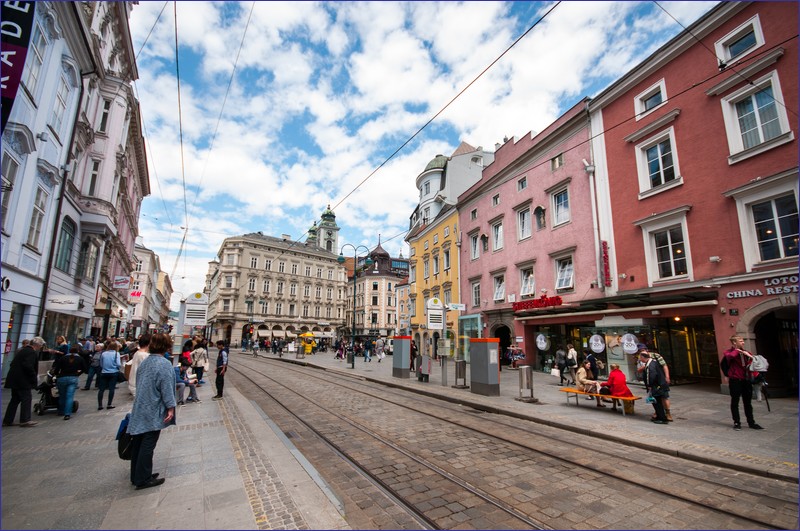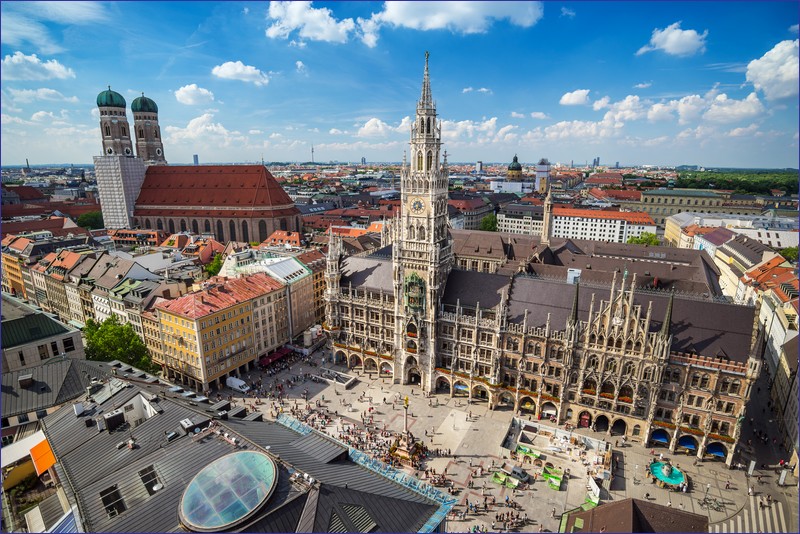Salzburg is a beautiful city and perfect starting point for one-day train trips to many places in Austria in Germany. I’ve prepared a post with suggestions for day trips from Graz by train. In the article, I’ve included places you can reach by regional train train within two hours one way. There are much more possibilities, especially if you want to travel by long-distance trains.
Direction: Bad Gastein
Hallein – formerly one of the most important estates of the archbishops in Austria, now known mainly for its salt mine open to tourists. The tour includes a ride on a wooden slide, a boat trip on a salty underground lake, and a ride on a mining train. Near the salt mine is another attraction – the reconstructed Celtic village Keltendorf Salina. In the town center, there is a museum dedicated to the carol Silent Night, composed by Hallein native Franz Xaver Gruber. It is worth noting that salt was already being mined on Mount Dürrnberg 2,500 years ago.
Golling Waterfall – located 3 kilometers from Golling-Abtenau train station, this beautiful waterfall is 75 meters high. A scenic hiking trail, open from May to October, leads to the waterfall.
Hohenwerfen Castle and Eisriesenwelt Caves – a majestic castle perched on a steep cliff at the edge of Werfen. Built in the 11th century by the archbishops of Salzburg, the castle took on its current appearance after a 16th-century reconstruction. It served as a defensive fortress and prison for many years. Today it is open to the public, and its falconry and falconer shows are especially popular. Just 4 kilometers from Werfen are the famous Eisriesenwelt caves – a vast network of underground chambers and corridors. The ice cave can be visited with a guide; tickets must be reserved online in advance. The cave entrance is at 1,641 meters above sea level, accessible via a cable car, followed by a 20-minute walk. Visitors light the cave interior with carbide lamps.
Pfarrwerfen (optional) – about 1 kilometer from the station, you can visit a small museum called Seven Mills, located along a stream, with some mills still in operation.
Bischofshofen – a town famous for its ski jump hill, where World Cup ski jumping competitions are held annually. The most valuable historical site is the parish church built at the turn of the 14th and 15th centuries. Modest from the outside, it features many architectural details inside.
Liechtensteinklamm – one of Austria’s deepest and most beautiful gorges, a popular hiking destination. Only 1 km of the gorge is open to visitors. At the end of the trail is a 60-meter waterfall, accessible via a 50-meter tunnel. The nearest train station is Schwarzach im Pongau-St. Veit Bahnhof (4.5 km away). A small museum about the Tauern Railway is located at the station. 4.5 km west of the station is a regional museum in Goldegg Castle.
Dorfgastein (optional) – 4.5 km north of the station lies Klammstein Castle (Burg Klammstein) featuring a small private museum and a restaurant.
Bad Hofgastein (optional) – the spa center is located about 3 km from the train station (though this may change due to rail line reconstruction). Attractions include a waterfall and a preserved mill, with many picturesque hiking trails in the surrounding area.
Bad Gastein – Austria’s most famous spa town. The thermal waters here contain radon. Spa-goers are transported underground by mining train to inhale radon-rich air. The town feels like a vibrant metropolis nestled in the mountains, full of hotels, shops, and tourists.
Zell am See – much of the railway line to Bad Gastein overlaps with the route to Zell am See. This well-known winter sports resort is the main city of the Pinzgau region and a gateway to the High Tauern National Park. Its most important monument is the parish church of St. Hippolytus, with beautiful frescoes. In winter, the town is packed with skiers who enjoy hundreds of kilometers of ski slopes. In summer, paragliders launch from the mountain slopes, and vacationers swim in the lake. Nearby is the Kitzsteinhorn Glacier.

Direction: Linz
Traveling on the S-Bahn train from Salzburg to Linz takes just over two hours, but due to the city’s importance, it is included in this guide.
Wels (optional) – a city of about 65,000 residents with a charming market square and historic townhouses. Remnants of city walls and an old water tower have been preserved. The City Museum (Stadtmuseum) in a former castle receives very good reviews. A small zoo operates on the outskirts of Wels. For a panoramic view, visit the Marienwarte viewing tower in Thalheim bei Wels on the opposite bank of the Traun River.
Linz – one of Austria’s largest cities with about 200,000 inhabitants. In the historic part of the city, the main landmark is the New Cathedral, built between 1862 and 1924. A stroll through the main square (Hauptplatz) is worthwhile, where a plague column from 1723 stands. Surrounding buildings include the town hall and the city history museum. Shopping lovers should head to Landstraße, the city’s main shopping street and one of the most popular in Austria. A common excursion destination is Pöstlingberg, a hill on the Danube’s left bank, away from the city center. There is a historic church at the summit, as well as parks, green areas, and a zoo. Museum highlights include the futuristic Ars Electronica Center, an interactive blend of science lab and museum, and the Lentos Art Museum on the Danube riverbank.

Direction: Munich
Freilassing (optional) – railway enthusiasts can visit the small Lokwelt railway museum housed in a former locomotive depot.
Prien am Chiemsee – one of two stations serving Bavaria’s largest lake. A tourist destination, especially in summer, when a narrow-gauge railway connects Prien with Stock on the lake’s edge (2 km long). Trains feature steam or diesel engines with vintage carriages.
Bad Endorf (optional) – a town with well-known thermal baths, popular among Bavarians and tourists.
Munich – one of Germany’s largest cities. Visiting Bavaria’s capital takes several days due to the vast number of monuments, museums, churches, and family attractions. The Old Town lies close to the main train station. On a one-day trip, highlights include Marienplatz and its surrounding landmarks: the New Town Hall, Cathedral of Our Lady (Frauenkirche), the Old Pinakothek with its European art collections, numerous churches, and the State Museum (Residenz). Munich has much more to offer, but museum visits and attractions will take longer than a single day.
Related articles:
Train travel in Austria – a comprehensive guide
Train travel in Germany – a comprehensive guide
Pinzgauer Lokalbahn – a general overview
One-day train trips from Munich
